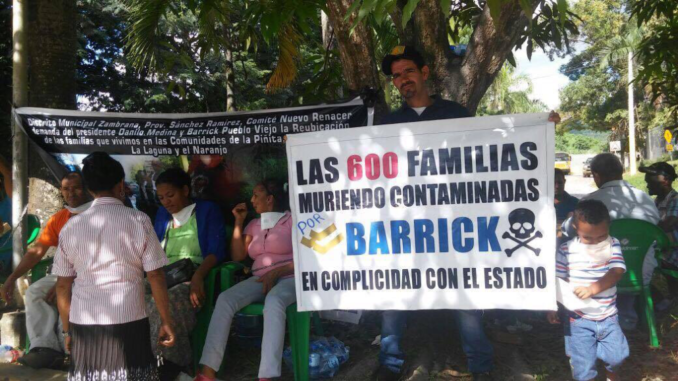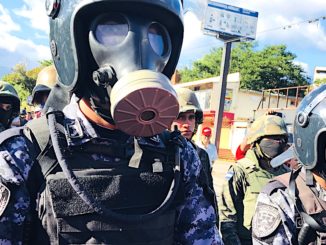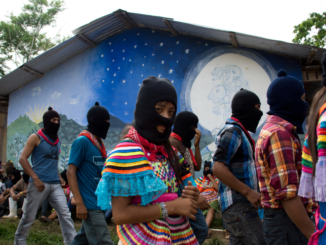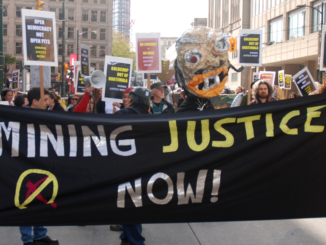
“El agua vale mas que oro,” or in English “Water is worth more than gold,” a young boy chants along with members of his community in Las Piñitas, Dominican Republic. He was born and raised here, neighboring the largest foreign direct investment project the country has ever seen – the Pueblo Viejo gold mine.
Pueblo Viejo, owned by Canadian companies Barrick Gold Corporation (60 percent) and Goldcorp Inc. (40 percent), two mining companies with notoriously abysmal human rights records, began commercial production in 2012. Since then, community members of Las Piñitas, Las Lagunas, El Naranjo, and La Cerca have expressed great concern regarding environmental devastation, which they believe has directly impacted their health and livelihoods.
After years of attempts for dialogue with little response from the company, community members have taken direct action. Since the early hours of Nov. 6, they have occupied space outside of Barrick Gold’s production site. Armed with signs, pollution masks and their voices, community members have chained themselves to chairs, refusing to leave until the demands of relocation for more than 600 families impacted by the project are met.
Unfortunately, communities in this area are not unfamiliar to such struggles, as mega-mining on their land dates back to the 1970s. The zone in which Pueblo Viejo now sits was historically a small mining site, state-run from 1975 until 1999, by company Rosario Dominicana. The operation was shut down due to mismanagement and lack of financial resources. However, the company’s operations exposed enough sulfide ore to initiate acid mine drainage which left a community water source, the Margajita River, in an acidic state. Although the mine was closed, community suffering did not end. When Barrick acquired the site in 2006 they invested close to $4 billion in updating the extraction method to a process called pressure oxidation, which uses the four largest autoclaves in the world. This new technology allows them to extract gold from low grade ore that Rosario Dominicana could not. However, this new extraction process is extremely resource intensive and uses industrial quantities of cyanide in the process.
In light of allegations that the company is shirking its stated corporate social responsibility mandate, Barrick tries to pass the blame by stating that the current concerns of communities are a result of contamination caused by Rosario Dominicana’s previous operations.
Support independent journalism by becoming a subscriber on Patreon.
However, community members strongly disagree.
A man from Las Piñitas states, “Barrick Gold says that the environmental impact that exists were left by the former Rosario Dominicana. But with Rosario Dominicana, at least we had water.”
The communities insist that the impacts of mining have significantly worsened since the Barrick began operating in the area. The government’s insufficient records of water samples in the area leaves the communities with no baseline for analysis, which is how community members believe Barrick is avoiding accountability. However, the environmental impacts of open-pit mining are undeniable.
Open-pit mining involves excavating and relocating large amounts – in some cases entire mountains – of surface earth and the underlying “waste rock” in order to expose the desired ore. Once removed, the ore is crushed into a powder-like consistency and showered in cyanide to dissociate the gold from the rock. This method poses far-reaching environmental dangers as approximately 79 tons of waste are produced to extract just one ounce of gold. Barrick claims that they have the ability to process a combined total of 24,000 tons of ore per day using industrial quantities of cyanide, leading to 1 million ounces of gold per year.
Individuals within the community, along with experts in the field, maintain that the alleged increased contamination within the area could be caused by the extensive use of cyanide at the Pueblo Viejo mine and the lack of suitable measures to dispose of the residue acid mine drainage. Experiences of those in surrounding communities confirm this, with neighbors stating that gases and odors emitted from the mine and tailings ponds induce debilitating symptoms. A youth from Las Piñatas explains, “when we are at school and the odor arrives we vomit, we have nausea, we have headaches, we are dizzy … everything. The teachers have to send us home and we can’t even learn.”
Nauseating odors are not the only health concern that community members experience, with over 50 members of the communities with lesions on their bodies. Most people identify that these lesions appeared after having direct contact with the water in the area, leading them to believe it is due to mine contamination. The lesions are consistent with skin damage caused from cyanide exposure which has been a main concern for the community. Due to this, members of surrounding communities underwent blood testing in an attempt to portray the toxic impact of the mining process; all five tested positive for cyanide traces above accepted safe levels. Furthermore, a community member, living beside the mine, alleges, “There have been 23 people in the community who had zinc, lead and chromium in their blood. This was an analysis done by a doctor in Santo Domingo. But Barrick would never admit this.”
barrick golds exploiting& exposing workers to deadly toxins& killing dominican rivers& farms https://t.co/DOBtcmpJ5Q pic.twitter.com/RSiy986DSR
— zahira (@bad_dominicana) March 25, 2016
Great concern has also been raised in regards to a drastic decline in agriculture production. The communities allege that they have lost over 80 percent of cacao, a source of income that many families depend on. Another community member adds, “Now you have to buy a mango to be able to eat. Before there were hundreds under the trees.”
Another cause for concern regarding community pollution is a potential spillage of the acid mine drainage within the tailing ponds. Tailings ponds are historically known for overflow and cracks, allowing toxic substances to leak into local water sources. The devastating impact of cyanide is recorded in a spill in Romania in the year 2000 where a tailings pond leaked cyanide contaminated water and heavy metals into local river systems. This spill caused extensive pollution throughout Romania, Hungary, Serbia, Bulgaria, and the Black Sea. The threat of such a spill at ‘Pueblo Viejo’ is a major concern, as the Dominican Republic is small enough to fit into Romania six times.
This fear almost became a reality last November when the “El Llegal” tailings pond rose to what community members believe to be dangerous levels after heavy rainfall in the area. One community members shared that although mine employees were evacuating due to a “red alert” and sirens, families living directly below the tailings pond were not informed as to what was occurring. Since then, communities have created a security system in which members do overnight shifts to ensure that, in the case of a spillage or disaster at Pueblo Viejo, they will have enough time to inform and evacuate the families in the area.
Although a large spillage has not yet occurred, community members believe that their local water sources are still being impacted. They allege that the water they previously drank directly from the local rivers is now unsafe for drinking, cooking, or even bathing. Because of this, Barrick initially in 2013 provided families with eight bottles of water per week, but that eventually changed. “[Barrick] found that this public service was too expensive and they were damaging their reputation in the media,” explains the community member. “When you went to the internet and the first thing that came up was that they were giving out large supplies of water, it meant that they had accepted that the water was damaged. So they regretted it and they took the bottled water from us.”
“Barrick Gold could be compared to a cancer, a cancer that grows bit by bit, destroying each one of our organs, until it takes our lives.”
Another community member describes the urgency of the situation: “I have lived in this community for 82 years and the last years that Barrick has been here have been the worst years of my life,” she said, as tears stained her face while she continued. “We are too poor to relocate and are stuck here dying because people in your country need to wear gold on their fingers.”
This sentiment is shared with another neighbor to the mine who explains, “Barrick Gold could be compared to a cancer; a cancer that grows bit by bit, destroying each one of our organs, until it takes our lives.”
Although over 75 percent of the world’s mining companies are headquartered in Canada, the Canadian government refuses to impose any sort of environmental or human rights regulations on Canadian corporations functioning outside of the country. A poignant example of this is the failure of Bill C-300, “Corporate accountability for the activities of mining, oil, or gas corporations in developing countries,” which was a small step towards corporate accountability proposed by Liberal John McKay in 2010. This bill sought to create a nationwide standard for corporate social responsibility (CSR) and would cut government funding for those corporations who failed to abide. However, after its proposal mining, oil, and gas companies hired over 300 lobbyists to oppose the bill, and it failed by a mere six votes.
“This is an abuse of authority by the powers of Barrick Gold and the Canadian and Dominican Governments,” says a woman from Las Piñitas. “I say this with full confidence, because no man, woman, or child should be afraid to tell the truth!” Community members continue to speak this truth as they occupy the space out front of Barrick’s Pueblo Viejo office demanding relocation for community members.
They have now been demonstrating for over a week with no response from Barrick or the Dominican government. However, this has not damaged their strength and determination and community members plan to stay in resistance for as long as necessary. As one woman from the community declared, “There is no secret that where there is a mining area there is pollution. Wherever there is an area of mining there is horrible poverty, because they take the riches, while we are left with holes… The people have to get up with one voice before they damage the whole country. What will they leave us with? The dead to be buried? … Barrick Gold, leave the country!”
If you wish to support community members demand for relocation, please sign and share this online petition and directly email Barrick’s Pueblo Viejo project manager at pvdcommunications@barrick.com
Klaire Gain is a Masters student in the Social Justice and Equity studies program at Brock University. She utilizes an Ecofeminist framework to investigate the impacts of Canadian mining companies within Latin America and the Caribbean. Klaire visits the communities neighboring by the Pueblo Viejo gold mine twice a year and brings home their narratives and experiences to share with Canadians and promote mining justice. All of the quotations within this article are direct narratives from footage obtained and communication with community members.
Copyright, Upside Down World. May not be reprinted without permission.
References
http://www.barrick.com/files/responsibility/Barrick-CSR-Charter.pdf
Barrick Gold. (2013) Responsibility Report: Environmental Data
http://barrickresponsibility.com/media/11696/Environment.pdf
Dominican Today. (2014) People near Gold mines test positive for Cyanide.
Engler, Yves. (2012) The Ugly Canadian: Stephen Harpers foreign Policy
Golder Associates. (Dec. 2014). ICMC Initial Certification Summary Audit Report: Pueblo Viejo Mine Dominican Republic. Found at:
http://www.cyanidecode.org/sites/default/files/pdf/BarrickPuebloVeijoSAR2015.pdf
Hatch Group. (July 2012) The Hatch Report: Delivering the World’s Largest Autoclaves for Barrick Gold. Found at:
https://www.hatch.ca/News_Publications/Hatch_Report/HR_July2012/barrick.html
McGill Research Group Investigating Mining in Latin America
http://micla.ca/conflicts/pueblo-viejo-2/
Rodriguez, V. (2011). Natural Resource Exploitation in the Caribbean: From Colonialism to Neoliberalism, Case Study of the Pueblo Viejo Gold Mine in Dominican Republic. University of Sussex. Found at:



